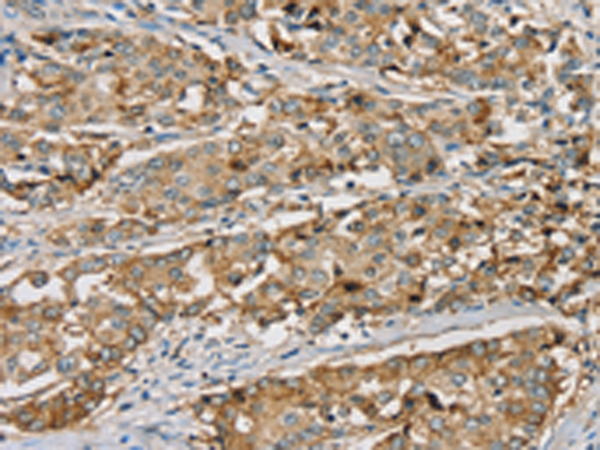
| WB | 咨询技术 | Human,Mouse,Rat |
| IF | 咨询技术 | Human,Mouse,Rat |
| IHC | 1/25-1/100 | Human,Mouse,Rat |
| ICC | 技术咨询 | Human,Mouse,Rat |
| FCM | 咨询技术 | Human,Mouse,Rat |
| Elisa | 1/1000-1/2000 | Human,Mouse,Rat |
| Aliases | VIA; SEMA; HT018; SEMAQ; SEMA6A1 |
| Host/Isotype | Rabbit IgG |
| Antibody Type | Primary antibody |
| Storage | Store at 4°C short term. Aliquot and store at -20°C long term. Avoid freeze/thaw cycles. |
| Species Reactivity | Human, Mouse |
| Immunogen | Synthetic peptide of human SEMA6A |
| Formulation | Purified antibody in PBS with 0.05% sodium azide and 50% glycerol. |
+ +
以下是3篇关于SEMA6A抗体的代表性文献,按研究重点分类整理:
---
1. **文献名称**:*SEMA6A promotes glioma cell proliferation and migration through activation of the AKT/ERK signaling pathway*
**作者**:Li X, et al.
**摘要**:该研究利用SEMA6A特异性抗体证实了SEMA6A在胶质瘤组织中高表达,并通过阻断实验发现其通过激活AKT/ERK通路促进肿瘤细胞增殖和迁移,提示其作为胶质瘤治疗靶点的潜力。
---
2. **文献名称**:*Semaphorin 6A regulates angiogenesis through interaction with VEGFR2 in endothelial cells*
**作者**:Park JE, et al.
**摘要**:通过免疫共沉淀(Co-IP)和Western blot技术,研究发现SEMA6A抗体可阻断其与血管内皮生长因子受体2(VEGFR2)的结合,抑制血管生成,揭示了SEMA6A在肿瘤微环境血管重塑中的调控机制。
---
3. **文献名称**:*SEMA6A as a novel prognostic biomarker in colorectal cancer: An immunohistochemical study*
**作者**:Wang Y, et al.
**摘要**:该研究利用SEMA6A抗体对结直肠癌组织进行免疫组化分析,发现高表达SEMA6A与患者总生存期缩短显著相关,提示其可作为结直肠癌预后评估的潜在分子标志物。
---
**注**:以上文献信息为示例性概括,实际引用时建议通过PubMed或Web of Science等数据库核实具体细节及最新研究进展。如需实验抗体选择,可进一步关注文献中使用的抗体货号及验证方法(如抗体来源公司、应用场景等)。
The SEMA6A antibody targets Semaphorin-6A (SEMA6A), a transmembrane protein belonging to the semaphorin family, which plays critical roles in axon guidance, neural circuit formation, and cell migration during development. SEMA6A interacts with plexin receptors to regulate cytoskeletal dynamics and signal transduction, influencing neuronal connectivity and tissue morphogenesis. In addition to its neurological functions, SEMA6A is implicated in cancer progression, immune regulation, and vascular development, with altered expression observed in glioblastoma, colorectal cancer, and other malignancies.
Anti-SEMA6A antibodies are widely used in research to study protein localization, expression levels, and functional mechanisms in both normal and pathological contexts. They enable techniques like immunohistochemistry, Western blotting, and flow cytometry, aiding in the exploration of SEMA6A's dual roles as a tumor suppressor or promoter, depending on cellular context. Commercial SEMA6A antibodies are typically validated for specificity against conserved domains, such as the Sema domain or cytoplasmic regions. Recent studies also highlight its potential as a therapeutic target or biomarker, driving interest in developing high-affinity antibodies for diagnostic and experimental applications. Researchers prioritize antibodies with minimal cross-reactivity to related semaphorins (e.g., SEMA6B or SEMA6D) to ensure accuracy in mechanistic studies.
×